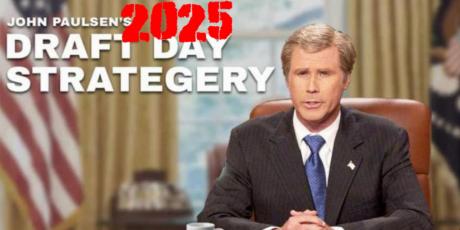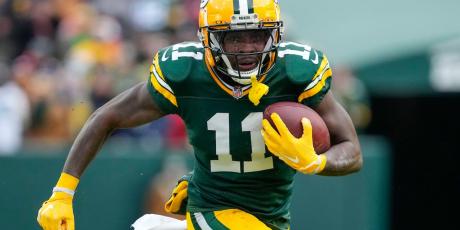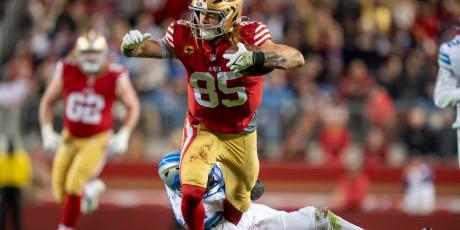How to Handle the 1.01 in a Dynasty Rookie Draft

This class is just different.
I'm relatively new to dynasty and have been told I've been spoiled. The first pick of the draft doesn't have the same edge to it. We don’t have a Saquon Barkley or an Ezekiel Elliot making the first pick easy. ‘Generational talent’ can take a rest. But a subset of dynasty leagues will be on the clock soon with an important decision to make. Unfortunately, it’s not as simple as it sounds.
The 1.01 pick in dynasty can be a double-edged sword. It holds the greatest value relative to the rest of the rookie draft. The highest graded asset of the incoming class is a guaranteed acquisition. Dynasty managers typically covet having this position as drafts draw near. But what did it take to get this pick? By default, the 1.01 pick reflects the previous year’s performance. Like the NFL, the worst team is placed at the front of the draft order. So, unless injuries were the primary cause, there are likely other issues that can’t be solved with a single pick. But let’s focus on the upcoming season.
My approach to handling the 1.01 starts with understanding its value. Value from both a quantitative and qualitative perspective. Using historical data, we can quantify how often the players valued at the 1.01 provide an immediate impact and their sustained fantasy relevance past their rookie seasons. But, if a trade offer comes your way or roster construction points to another player, we’ll l use a tool to look at multiple scenarios to fully capture the options available at the start of your rookie draft.
The Value of the 1.01
Twitter timelines have been inundated with analysis on the 2019 rookie class. However, we’re only waiting for the final data point: landing spot. It alters the player’s projected opportunity and their fantasy outlook over their rookie contract. Looking back over the past 5 years, the 1.01 has produced some of the top performers in the league.
The valuation process is different for everyone. Casual managers rely on the work of others. Fantasy sites dedicated to the format provide in-depth rankings with updates throughout the offseason. While ranking teams will differ on their 1.01, a range of top-tier players can be formed. Dedicated managers take a separate path. Through grinding tape or scraping game logs, personal rankings are established. All paths lead to the rookie draft with multiple producers for us to select.
|
2014 |
2015 |
2016 |
2017 |
2018 |
|---|---|---|---|---|
|
Ezekiel Elliot |
||||
Each player listed was either picked at the 1.01 or similarly valued during their rookie year. Let’s first acknowledge that fact. It’s their rookie season. Tight end has a known learning curve, quarterbacks need time to get in sync with both the game speed and their receivers, and both running backs and wide receivers must earn their share of touches. That’s the cyclic nature of dynasty. So while a few recent prospects may have underperformed (or not performed at all), it doesn’t mean their NFL career is over.
But we’re still looking for hits. More to the point, we’re looking for immediate hits at the cost of the 1.01. Hits for wide receivers and running backs were seasons where their final rank was within the Top 24 at their position. Quarterbacks and tight ends needed to finish within the Top 12 due to the replaceable nature of the position.
|
Years in the League |
Number of Hits |
|---|---|
|
Rookie Season |
7 |
|
1 Season |
4 |
|
2+ Seasons |
10 |
Rookies at the 1.01 have only provided a 36.8% hit rate over the last five years. Even further, those were only running backs and wide receivers. Hunter Henry? Nope. Jared Goff? See Fisher, Jeff. Even Baker Mayfield had to wait for Tyrod Taylor and Hue Jackson to move on to see the field. So, while we expect such a costly asset to produce, the odds aren’t always in our favor. But it gets better.
Approximately 21% of the rookie list only had one season of fantasy relevance. While landmines have found their way to the top of the draft, the expectation is that talent and situation will win out. Perceived value (or sustained value) can take the place of immediate impact. The hit rate for players past their rookie season jumps to 52.6%. Intuitively this makes sense. Fantasy success is at the intersection of talent, opportunity, and situation. Dynasty managers recognize talent. NFL managers (e.g. coaches and the players to an extent) provide the opportunity and situation. So, while 1.01 assets have a sense of impending use, the waiting period may be longer than expected.
The 2016 class is a clear example. While featuring marquee talent like Ezekiel Elliot, it took a seismic shift for Goff to improve. There’s still hope for Coleman and Doctson, but their careers to date show how the rookie evaluations process can generate both hits and misses. Injuries (e.g. Dalvin Cook) also negatively skew the results lending greater credence to the notion of monitoring the player’s situation. But, as more information is provided, dynasty managers can plan out a path of what to do with the asset.
Scenarios to Consider
After a quick look into value with historical examples provided, we turn to the 2019 class. Again, it’s different. Without a true consensus player valued at the 1.01, there are ways to approach the pick. Let’s walk through a couple of scenarios.
Hold and Draft
If this is a Superflex league, you’re drafting Kyler Murray. Full stop.
For all other formats, process dictates choice. The Combine and subsequent Pro Days have shuffled many previously held rankings. However, even from a casual manager’s perspective, the same names keep surrounding the 1.01. ‘Draft for talent, trade for need’ encapsulates the cyclic nature of dynasty. So while the landing spots and median projections are still unknown, talent has been on display for months.
Analytics assesses talent through past production. Processes such as adjusting for size, speed, and competition attempt to equally compare prospects to players within their class those previous. Film analysis looks for traits. Footwork, route running, and on-field vision help answer the question of how the player produced. The confluence of these approaches creates a tier of high-value picks versus a singular player. While players like N’Keal Harry sit at the top, he’s not alone. Managers choosing to hold and draft at this position can select within the top-tier of rookies without a significant loss in expected value. But this flexibility in value creates a vacuum for managers to move within during the first few picks of the draft.
Players to Consider at Cost: Kyler Murray, N’Keal Harry, AJ Brown, D.K. Metcalf, Josh Jacobs
Trade Down
Go look at your Twitter timeline. Don’t close this article. But, just look. Who’s the 1.01 by public opinion? By industry analysts? This is problematic. The assumption that similar high-end value can be generated by multiple players lessens the value of the 1.01 pick. In other words, it decreases the likelihood of significant trade offers sent for the 1.01. So, if a king’s ransom doesn’t find its way into your inbox, what’s the recourse?
Trading down is a tactic used throughout dynasty drafts. It assumes a player of equal value will be available at the pick acquired in the trade. If multiple players are being considered at 1.01, moving back as far as the 1.05 while collecting additional assets can be advantageous. But which assets? The DLF Trade Analyzer quantifies the value of both players and picks under a variety of formats. Multiple trade scenarios were input into the tool to determine the equivalent value of the 1.01. A few examples are provided:
- 2019 1.04, 2020 2nd Round Pick, Duke Johnson Jr.
- 2019 1.04, Curtis Samuel
- 2019 1.05, Anthony Miller
- 2019 1.05, Royce Freeman
These are just starting points and each manager must tailor these their own league as value changes from person to person. But the objective remains. Setting player tiers versus using individual rankings manage expectations. It allows for a wider range of outcomes. Players in the top tier can still be acquired with the added bonus of gaining relevant assets.
Wrapping Up
Pick an analogy and drafting can become that. Chess where you must sacrifice pawns to protect the king. It’s war and you must study your opponent. Know their next move before they make it. The draft could even be a dance and the rhythm guides us. Trade-pick-pick-trade. Whichever you choose, let time on the success of the pick. Dynasty thrives on production. Production over time. Realizing that and building along a player’s development arc will keep your roster in contention every season.






















